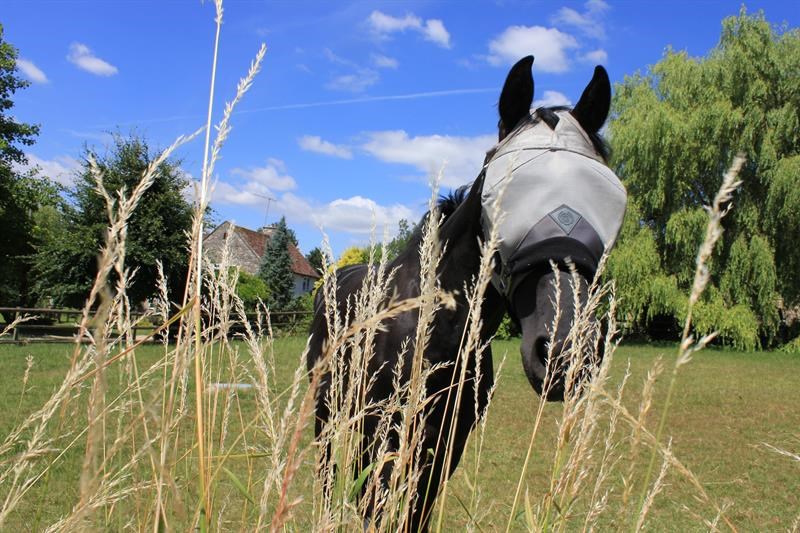While we all look forward to the prospect of long warm summer days and sunshine, for horses, it can lead to a range of ailments and conditions, not to mention the increase in biting insects. Rich Bristow BVet Med CertAVP MRCVS from Pinkham Equine Veterinary Services explains what to look out for and how best to prevent and manage your horses health in the summer months.
Sarcoids
Sarcoids are a type of skin tumour that come in six different forms, ranging from a slightly scaly area of skin to very large, unsightly and aggressive growths. They can be found anywhere but certain regions of the body have a higher prevalence - typically those areas of thin skin that are targeted by flies such as around the mouth and eyes, the girth region, the sheath and groin. Wounds can also run the risk of developing into Sarcoids. Evidence suggests that one potential cause is a Bovine Papilloma Virus, which may be spread from site-to-site and from horse to horse, by flies. Some sarcoids exude blood or serum either spontaneously or after being traumatised, making them particularly attractive to flies and causing marked irritation to your horse.
There are several different treatment options available for removal, ranging from the application of a rubber ring in isolated, well defined cases, to removal by cryotherapy or via laser surgery, either standing or under general anaesthetic, depending on the exact location and co-operation of the patient, however there is a risk of recurrence. In some cases this may be able to be performed at your yard.
Sweet Itch
An allergic response to midge bites, that predominantly causes itching, hair loss and skin thickening along the mane and at the top of the tail. The best form of treatment is to prevent the midges being able to bite the horse by introducing certain management routines:
- Use a fly rug, including a section to go underneath the abdomen and cover the horse from ears to tail.
- If turned out then ideally the field should be open and away from standing water and areas of rotting vegetation, such as muck heaps, where midges breed. Midges are weak fliers, so will struggle to bother horses in open fields.
- Make sure you regularly clean out all drinking troughs.
- Stable horses at dawn and dusk – the times of peak midge activity.
- Place an electric fan in the corner of you stable (out of reach!) to generate a breeze within the stable. Insect-proofing your stable by the application of fine mesh over the doors and windows will prevent midge access.
- Use an effective fly repellent, particularly those containing Pyrethrin. Remember to apply with care, and avoid using on damaged or broken skin.
Urticaria
The appearance of multiple raised lumps or wheals across the neck and body. Drugs, food, inhaled agents or heat may all cause Urticaria, but it is also often seen in response to an insect bite or sting. In many cases it will resolve itself without treatment, however sometimes the process may be accelerated or aided by an injection of corticosteroids. In repeat cases intradermal skin testing may be an idea to try and identify the cause.
Folliculitis/Dermatitis
This bacterial infection occurs when skin becomes warm and moist, creating the ideal environment for the bacteria to proliferate and infect the skin, whose defences are weakened by prolonged wetting. It may occur when rugs are placed over incompletely dry horses, or in areas where tack has been in contact with the skin which have not been adequately cleaned.
Wounds/abrasions
Even relatively minor abrasions can be attractive to flies and become infected as a result – cleaning using a very dilute solution of hibiscrub followed by application of a product such as Aluspray can prevent infection and form a barrier that prevents easy access for flies.
Pastern Dermatitis
Frequently known as Mudfever, outbreaks of Pastern Dermatitis are commonplace in the Spring and Summer in horses kept on long, wet grass. The persistence of rain or dew on long grass causes prolonged wetting of the lower limb, a weakening of the skin’s defences and bacterial infection. The condition maybe resolved by use of topical antibiotic and antiinflammatory creams in conjunction with stabling overnight and avoid turning out until the grass has dried.
Sunburn/Photosensitisation
Horses with pink muzzles are liable to suffer from sunburn. This may be combatted by use of fly masks with a muzzle flap, of high factor human sunblocks, or zinc oxide creams. Affected horses should also be kept out of the sun until the immediate redness has reduced. Occasionally horses with white patches may have widespread photosensitisation – this shows as areas of very red, crusty skin that will eventually die and slough off. They are very painful to the touch and on the lower limb are easily confused with Pastern Dermatitis. This disease can be indicative of an underlying liver condition and should be investigated by your vet.
For more information visit: www.pinkhamequine.com
